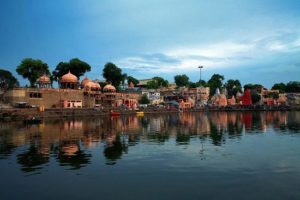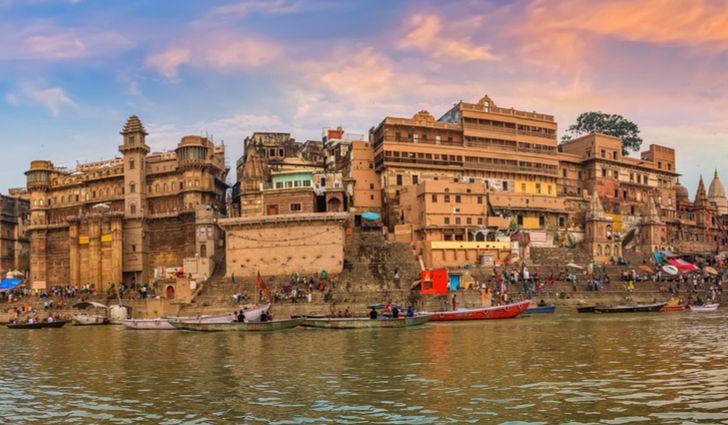A great devout center on the banks of river Shipra, Ujjain, in the central Indian state of Madhya Pradesh, is regarded as a sacred place since time immemorial. A holy city, which found its mention in the ancient Hindu scriptures as Avantika, Ujjain is positioned in equal terms with other major religious centers. Later the name was changed to Ujjayini, which literally means the glorious conqueror.
One among the seven sacred cities of the Hindus, Ujjain has been a high-flying center of spiritual activities for over 2,000 years. The sacredness of this township is attributed by the mythological legend that during ‘Sagar Manthan’, one drop of nectar spilled over Ujjain, which makes it a sacred place. Whatever be the truth behind this, Ujjain has got a considerable mention in the Vedas and it is believed that two parts of Skanda Purana, are supposed to have been composed here.
Ruined sculptures and monasteries have been found scattered around Ujjain, leading to the credence that Buddhism thrived here in the 4th century. A glut of these, along with ruined temples and old remnants of houses found in the district take the visitor to the historic reign of the Mauryan Empire.
Ujjain’s relevance is not constrained to the small circle of a religious place. Apart from that, this city was a haven of astronomers, and great poets. Besides this, Ujjain was ruled over by many great rulers who have given out their best to this historic city. The illustrious kings of the Gupta dynasty whose reign is considered as the golden rule of India belonged to Ujjain.
Festive occasions and fairs play a significant role in the lives of people in Ujjain and tourists should book Ujjain tour package during this time. An ancient religious centre, Ujjain is famous for the Kumbh Mela, Ardha Kumbh and Shivaratri. Today the city presents a unique blend of glorious past with the vibrancy of modernity. A plethora of ruined temples, damaged sculptures, ancient monasteries along with attractive monuments and a serene ambience, Ujjain provides unlimited opportunities of exploration.
Attractions
 Bhartruhari Caves: Bhartruhari Caves in Ujjain is believed to be the place where Bhartrihari, the step brother of Vikramaditya, lived and meditated after renouncing worldly life. His famous works, Shringarshataka, Vairagyashataka, and Nitishataka, were possibly written here.
Bhartruhari Caves: Bhartruhari Caves in Ujjain is believed to be the place where Bhartrihari, the step brother of Vikramaditya, lived and meditated after renouncing worldly life. His famous works, Shringarshataka, Vairagyashataka, and Nitishataka, were possibly written here.
Kalideh Palace: Situated on an island in the river Shipra, Kaliadeh Palace was built in the year 1458 AD by the Sultans of Mandu. The palace was demolished at the time of the Pindaris and was restored to its former glory by Madhav Rao Scindia in 1920. The central hall, which is surrounded with galleries, presents a classic example of Persian architecture. Though lost in the loneliness of the torrents of Shipra River, even now, this water palace holds some religious significance. People from the nearby villages take a dip in one of the tanks, which is called as Surya Kund.
Pir Matsyendranath: Pre-Islamic India held peers and saints with great respect and it is believed that they have attained spiritual awareness through stern atonement. Matsyendra, a peer belonging to the Natha sect of Shaivism lived in the outskirts of Ujjain, and Pir Matsyendranath is dedicated to the memory of this great leader.
Gomti Kund: The legendary place where Lord Krishna is believed to have summoned the holy rivers from all the pilgrim centers so that his old Guru could peacefully do all the rituals. Gomti Kund is a steeped water tank, which is situated near the Sandipani Ashram.
Bade Ganeshji Ka Mandir: Situated near the tank of the Mahakaleshwar Temple, Bade Ganeshji Ka Mandir holds a colossal statue of the elephant-headed God. The elephant head of the deity signifies wisdom, discretion and foresight that the Hindus attribute to divinity.
Chaubis Khamba Temple: An impressive structure, which belongs to ninth or tenth century AD, Chaubis Khamba Temple presents an architectural marvel. The majestic entrance gate of the magnificent Mahakala-Vana, the remains of which provide an amazing spectacle. Two splendid images of goddesses are depicted on each side of the gate with the inscription of their names on the foot steps.
Gopal Mandir: Dedicated to Lord Krishna, Gopal Temple in Ujjain presents a classic example of Maratha architecture. Built in the 19th century, by Bayajibai Shinde, this huge temple is placed in the middle of a big market. Its strategic position in the heart of the city is attributed to the popularity of the temple.
Kal Bhairav Temple: Bhairav is a fierce materialization of Lord Shiva, and the city of Ujjain has numerous shrines dedicated to this ferocious manifestation. Kal Bhairav temple is believed to be associated with the Tantra cult, a heretical secret religious group with brawny black magic nuances. The temple premises are mottled with holy men with ash smeared body and long matted hair.
Mahakaleshwar Temple: Mahakaleshwar Temple, cited by the great poet Kalidasa in his works, is dedicated to Lord Shiva. It is one of the 12 Jyotirlingas in India. The temple is a five-storied massive structure and its carved motives display the Rajput style of architecture while screens and pavilions combined with marble colonnades speak of the influence of Mughal style.
 Navagraha Mandir (Triveni): A unique temple dedicated to the planets of our solar system, Navgraha Mandir in Ujjain indicates that the planets need to be propitiated to avoid a negative influence. In India, Astronomy and Astrology adorned a pivotal role in the life of people of ancient times and the popular belief is that each planet exercises an influence on the lives of people.
Navagraha Mandir (Triveni): A unique temple dedicated to the planets of our solar system, Navgraha Mandir in Ujjain indicates that the planets need to be propitiated to avoid a negative influence. In India, Astronomy and Astrology adorned a pivotal role in the life of people of ancient times and the popular belief is that each planet exercises an influence on the lives of people.
Patal Bhairav Temple: A legendary temple, which holds an astounding story about the power of the mother Goddess, Patal Bhairav Temple has acquired a prime position. Hindu mythology states Bhairav Nath, a selfish demon, chased a young girl Vaishno Devi, who was none other than the incarnation of the Mother Goddess.
Ram Janardhan Mandir: Constructed by Mirza Raja Jaisingh in the seventeenth century, Ram Janardan temples present an eye-catching look. Presenting an outstanding structural elegance, these temples depict masterpieces of Maratha paintings on their walls. The Maratha Kings added some of the structures in the temples in the eighteenth century. The imposing pictures on the walls of the temples add to the charm of the temples.
Ram Mandir: Dedicated to Lord Ram who is flanked by his consort Sita on one side and brother Lakshman on the other, Ram Mandir is an eye catching spectacle. Built in the 17th century, this fabulous shrine is a fine example of structural brilliance. The walls of the pretty shrine are decorated with beautiful paintings.
Ram Mandir Ghat: Ram Mandir Ghat, located near the Harsiddhi Temple, is famous for its Kumbh Mela. Kumbh Mela is held every 12 years. Ram Mandir Ghat is the most ancient bathing ghat in connection with the Kumbh celebrations.
Sandipani Ashram: The ancient Indian tradition of Gurukul imparts education to students irrespective of their wealth or poverty. Besides a variety of subjects and ancient scriptures, in Gurukul students were taught battle techniques and spiritualism. From the Vedic period itself, Ujjain was a reputed center of learning.
Best period to visit Ujjain is from October to March.
How to reach
By Train: Ujjain Junction is an important railway station in Western railway zone. It is well connected to all major railway stations in India.
By Air: Devi Ahilyabai Holkar Airport in Indore is the nearest to Ujjain, which is situated 55 km away. Indore is air connected to major cities in India by public and private domestic airlines.
By Bus: Ujjain is well connected by state road transport public bus services. Regular bus services are available from Indore (55 km), Gwalior (450 km), Ahmedabad (400 km) and Bhopal (195 km) to Ujjain. Super fast and Deluxe A/C buses are also available on these routes.







